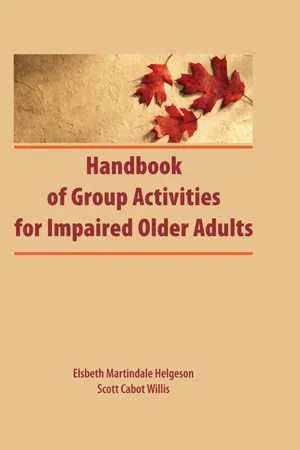
- 120 pages
- English
- ePUB (mobile friendly)
- Available on iOS & Android
Handbook of Group Activities for Impaired Adults
About This Book
Here is a one-of-a-kind resource for professionals who prepare and lead group activities for impaired older adults. Filling a crucial gap in the field of clinical gerontology, this invaluable guide provides more than 70 stimulating and therapeutic group activities designed specifically for use with moderately to severely impaired older adults. Even though group activities designed for children, adolescents, and young adults are inadequate and inappropriate for use with older adults who have significant cognitive, emotional, and physical limitations or impairments, very little has been published--until now--on activities designed to meet the special needs of this population.Comprehensive and well-organized
This comprehensive and well-organized resource does even more than provide over 70 activities at your fingertips. It also includes a recommended schedule of activities for a typical day, helpful suggestions for planning and leading group activities, and valuable tips for creating your own group activities that are effective, therapeutic, and entertaining. Each entry includes information on the activity's therapeutic value, the optimal group size, the time required, the materials needed, guidelines for adaptation, and blank space for your notes. Also for your convenience, symbols are used to indicate the therapeutic objective and the ease with which the activity can be implemented. Provides the foundation for a daily activities program
Handbook of Group Activities for Impaired Older Adults provides the foundation for a therapeutic and enjoyable daily activities program that facilitates emotional expression, enhances problem solving skills and sensory stimulation, and encourages social interaction. Social workers, nurses, psychologists, psychiatrists, recreational therapists, group therapists, and related paraprofessionals who work in nursing or convalescent hospitals, adult day care or day treatment facilities, and retirement homes will not want to be without this practical guidebook.
Frequently asked questions
Information
Activities
Actors and Actresses


TIME INVOLVED: 10-45 minutes
MATERIALS NEEDED: none
DESCRIPTION/DIRECTIONS: Individuals volunteer to act in one of the following categories without using words:
- 1) emotions - rage, despair, hope, fear, misery, happiness, infatuation, joy, jealousy, peace, sorrow, pride, inferiority, suspicion, frustration, etc..
- 2) trades - truck driver, ditch digger, bus driver, lumberjack, violinist, painter, school teacher, cook, farmer, athlete, auto mechanic, etc..
- 3) sensations - hunger, howling wind, quiet stream, soft whisper, angry storm, crashing waves, happy memory, bad dream, gentle rain, fog creeping in, beautiful flower, creaking door, tumbling leaves, falling snowflake, slithering snake, etc..
GUIDELINES FOR ADAPTATION:
Attending to Feelings


TIME INVOLVED: 10-60 minutes
MATERIALS NEEDED: Feeling list (see next page) and chalkboard (possibly magazines)
DESCRIPTION/DIRECTIONS: Feelings may be explored in many ways. Several ideas are listed below:
- 1) List three feelings that are somewhat similar in nature (e.g., happy, joyful, elated). Discuss the differences in the three feelings. Ask for examples of when these feelings were felt.
- 2) Write a feeling word on the board and discuss its meaning. Ask for examples of when someone has felt that feeling or ask someone to make up a story involving that emotion.
- 3) Draw a “feeling face” on the chalkboard, in simple form, that depicts the expression of a feeling. Several can be drawn at once and the description of the affect could be listed below, making the task a matching one. Have group members identify the feelings and discuss it. The discussion can include when they may have felt this in the past or what thoughts are associated with the feeling. (An excellent poster titled “How Do You Feel Today?” is a useful tool for drawing faces.)
- 4) Ask individual group members to nonverbally depict certain feelings using facial expressions or other nonverbal forms of communication.
- 5) Cut pictures from magazines (or other sources) depicting human faces expressing various emotions. Discuss the feelings portrayed in each picture. Ask members to tell a story about what they think might have happened to make the person feel the way they do. Ask for examples of times when group members have felt similar feelings.
- 6) In small groups look through magazines for pictures to express specific feelings. Cut out the pictures and make posters.
NOTES:
Feeling List
affectionate
ambivalent
angry
annoyed
anxious
apathetic
awed
bad
betrayed
bitter
blue
bold
bored
brave
bubbly
burdened
calm
capable
challenged
cheated
cheerful
childish
competitive
confused
content
crushed
defeated
delighted
despair
determined
distracted
disturbed
dominated
dynami...
Table of contents
- Cover Page
- Half Title Page
- About the Authors
- Title Page
- Copyright Page
- Contents
- Editor
- Foreword
- Preface
- Introduction
- What Do We Mean by “Impaired?”
- Philosophy of Treatment
- Guidelines for Leading a Group Activity
- Types of Group Activities
- Schedule for a Typical Day
- Planning Group Activities
- On Hand Materials
- Activities
- Generating Your Own Activities